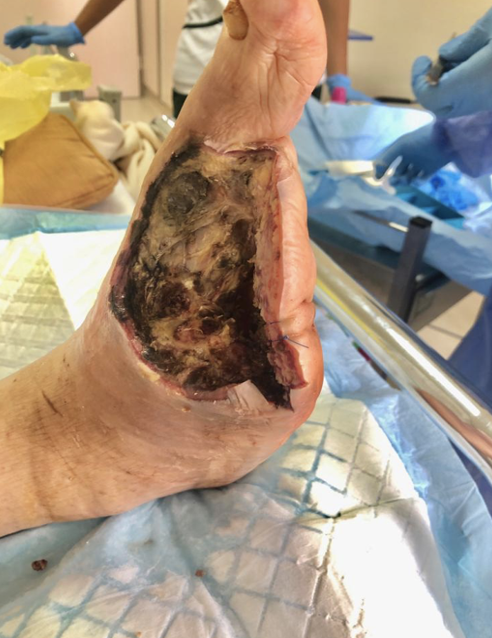Mucormycosis as a Rare Infection in Lower Limb Necrotizing Fasciitis: A Case Report
DOI:
https://doi.org/10.38179/ijcr.v3i1.281Keywords:
necrotizing fasciitis, mucormycosis, amputation, amphotericin, case reportAbstract
Introduction: Necrotizing fasciitis is a severe, life-threatening infection that can be fatal and rapidly progressive. It is usually caused by polymicrobial infection, monomicrobial infection by group-B streptococci (GBS) or staphylococci, or by anaerobes like Clostridium difficile that presents as a gas gangrene or rarely by fungi. Fungal infections, though found in diabetic foot ulcers, remain extremely rare agents in necrotizing fasciitis, often causing severe morbidity and higher mortality than regular bacterial infections. Though severe, these infections are not often late to diagnose and very few reports exist citing their presence. With our case report, we present another rare manifestation of Mucormycosis in a foot wound.
Case Report: We present a 57-year-old diabetic male patient who presented with a rapidly progressing very painful right foot ulcer, with high-grade fever and fatigue that did not respond to surgical intervention and treatment with broad-spectrum antibiotics. Mucormycosis species were identified in wound cultures. The patient then underwent an amputation and was treated with liposomal Amphotericin B.
Conclusion: This report aims to further highlight that virulent fungal infections, especially mucormycosis, should be considered when suspecting or diagnosing necrotizing fasciitis. An extensive review of the literature with our newly added case would serve as an eye-opener on this pathogen in the setting of difficult-to-treat necrotizing fasciitis.
References
Necrotizing Fasciitis: Practice Essentials, Background, Pathophysiology. Published online October 12, 2022. https://emedicine.medscape.com/article/2051157-overview#a3.
Neblett Fanfair R, Benedict K, Bos J, et al. Necrotizing cutaneous mucormycosis after a tornado in Joplin, Missouri, in 2011. N Engl J Med. 2012;367(23):2214-2225. PMID: 23215557. https://doi.org/10.1056/nejmoa1204781
Paz Maya S, Dualde Beltrán D, Lemercier P, Leiva-Salinas C. Necrotizing fasciitis: an urgent diagnosis. Skeletal Radiol. 2014;43(5):577-589. PMID: 24469151. https://doi.org/10.1007/s00256-013-1813-2
Chander J, Stchigel AM, Alastruey-Izquierdo A, et al. Fungal necrotizing fasciitis, an emerging infectious disease caused by Apophysomyces (Mucorales). Rev Iberoam Micol. 2015;32(2):93-98. https://www.elsevier.es/es-revista-revista-iberoamericana-micologia-290-articulo-fungal-necrotizing-fasciitis-an-emerging-S1130140614000783
Bonifaz A, Stchigel AM, Guarro J, et al. Primary cutaneous mucormycosis produced by the new species Apophysomyces mexicanus. J Clin Microbiol. 2014;52(12):4428-4431. https://doi.org/10.1128/jcm.02138-14.
Carr L, Michelotti B, Potochny J, et al. Scedosporium: an unlikely cause of fungal ne-crotizing fasciitis. Am Surg. 2015;81(6):E253-E254. PMID: 26031258
Kückelhaus M, Hirsch T, Lehnhardt M, Daigeler A. Nekrotisierende Fasziitis der oberen und unteren Extremität [Necrotizing fasciitis of the upper and lower extremities] [published cor-rection appears in Chirurg. 2017 Oct 30;:]. Chirurg. 2017;88(4):353-366. PMID: 28289755. https://doi.org/10.1007/s00104-017-0397-0
Franko J, Baumchlová H, Frankovicová M, et al. Non-streptococcal Necrotizing Fasciitis in a Diabetic Patient with Fungal Superinfection: a Case Report. EJVES Extra. 2001;2(1):7-8. https://doi.org/10.1053/ejvx.2001.0068
Hite M, McCrae AL, Privette A. Fungal Necrotizing Fasciitis after Penetrating Trauma. Am Surg. 2018;84(8):e302-e304. PMID: 30454456
Mugambi MS, Theron A, Cox S, Pillay K, Millar AJW, Numanoglu A. Disseminated mu-cormycosis and necrotizing fasciitis in immune-compromised patients: Two case reports. Ann Pediatr Surg. 2015;11(1):35-39. https://doi.org/10.4314/aps.v11i1
Toma A, Mazilu L, Suceveanu A, et al. Diabetes mellitus and necrotizing fasciitis – a deadly combination; case report. J Mind Med Sci. 2020;7(1):119-127. https://scholar.valpo.edu/jmms/vol7/iss1/20?utm_source=scholar.valpo.edu%2Fjmms%2Fvol7%2Fiss1%2F20&utm_medium=PDF&utm_campaign=PDFCoverPages
Khanna M, Challa S, Kabeil AS, et al. Risk of Mucormycosis in Diabetes Mellitus: A Sys-tematic Review. Cureus. 2021;13(10):e18827. Published 2021 Oct 16. PMID: 34804684. https://doi.org/10.7759%2Fcureus.18827
Richardson TE, Lee NE, Cykowski MD, Chang SA, Powell SZ. Necrotizing fasciitis as the initial presentation of disseminated infection with fluconazole-resistant Cryptococcus neoformans. JMM Case Rep. 2014;1(4):e003608. Published 2014 Dec 1. PMID: 28663814. https://doi.org/10.1099/jmmcr.0.003608-0
Prasanna Kumar S, Ravikumar A, Somu L. Fungal necrotizing fasciitis of the head and neck in 3 patients with uncontrolled diabetes. Ear Nose Throat J. 2014;93(3):E18-E21. PMID: 24652565
Cornely O, Chakrabarti A. PS1284 GLOBAL GUIDELINE FOR THE DIAGNOSIS AND MANAGEMENT OF MUCORMYCOSIS: AN INITIATIVE OF THE ECMM IN COOPERATION WITH THE MSG ERC. HemaSphere. 2019;3(S1):588. https://doi.org/10.1097/01.HS9.0000563416.43453.d2

Published
How to Cite
Issue
Section
Copyright (c) 2022 International Journal of Clinical Research

This work is licensed under a Creative Commons Attribution 4.0 International License.







